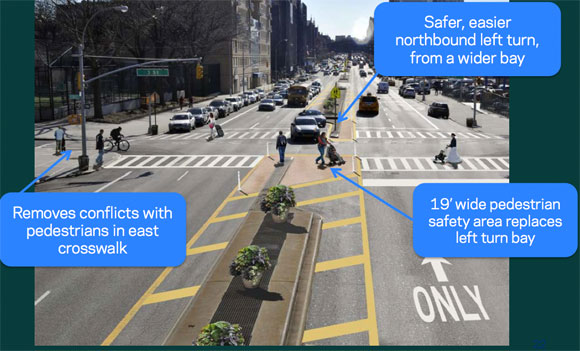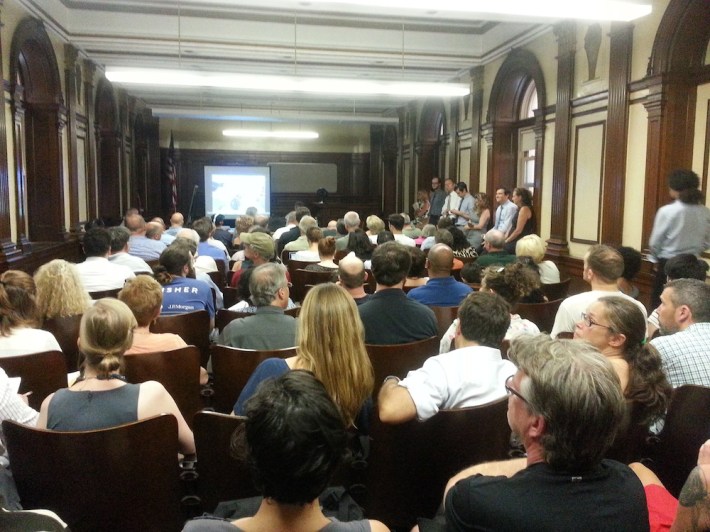One month after Brooklyn Community Board 6 passed a resolution condemning DOT's safety proposal for Fourth Avenue, upending months of public workshops and the decision of its own transportation committee, the full board voted 21-3, with two abstentions, to support a modified version of the plan at a special meeting last night.
Beginning in February, DOT held public workshops to craft the plan, which is similar to changes that were supported by CB 7 and implemented in Sunset Park last year. The street would be tamed with wider pedestrian medians, left-turn restrictions, and a reduction from three lanes in each direction to two. DOT project manager Jesse Mintz-Roth noted that the workshops attracted up to 100 people each. "There's been extensive public input on this project," he said.
In the wake of CB 6's unexpected rejection of the plan, Council Members Brad Lander and Stephen Levin, who appoint members to the board, asked DOT to move forward without the CB's stamp of approval. But board chair Daniel Kummer urged DOT to modify the plan before last night's special meeting, which he called specifically to address the Fourth Avenue project.
Most of DOT's presentation last night [PDF] focused on the plan's benefits not only to pedestrians, but also drivers. Mintz-Roth reviewed the rationale and planning process behind the proposal, which did not receive much explanation at last month's meeting before the board voted to reject it.
The tweaks DOT made to its plan were relatively modest, but include some changes that will weaken the safety benefits of the original proposal.
- The new plan retains three lanes of traffic northbound on Fourth Avenue starting at Carroll Street, rather than Union Street, as previously planned. This change adds two extra blocks where DOT retains the existing street design to accommodate morning rush hour backups.
- There are now six left turn bans from Fourth Avenue, rather than eight. Under the new plan, left turns from northbound Fourth Avenue to Degraw and Bulter streets have been retained. As a result, the median in these locations will not be widened as much as previously planned.
- A painted curb extension will be added at the southeast corner of Fourth Avenue and Fifth Street. Separately, Fifth Street is on track to receive speed humps before the start of the school year, at the request of the principal of M.S. 51.
Along with an extensive question-and-answer session with DOT staff, these changes were enough to win the unanimous support of the transportation committee and the overwhelming support of the full board.
Residents of Fifth Street showed up at last month's meeting to oppose left turn restrictions at Third and Ninth Streets that they feared would lead to increased traffic by their homes. During last night's public comment period, 13 people spoke, with nine in favor and four against. All but one of the public speakers against the plan lived on Fifth Street.
Mintz-Roth explained that the number of drivers diverted by the left-turn restrictions would actually be quite low, and that side streets could expect to see two or three additional vehicles per hour as a result. Because Fifth Street begins at Fourth Avenue, he noted, it already has low traffic volumes.
Fifth Street residents, supported by Council Member Lander, have also requested a traffic signal at the intersection with Fourth Avenue. "We would love for that answer to be yes," Mintz-Roth said, but said DOT's signals division has determined that the intersection did not meet its warrant requirements for a stop light. After the traffic calming plan is implemented, the signals division will re-examine the intersection to see if a light would meet its standards.
The plan aims to cut down on speeding, which Mintz-Roth described as occurring "everywhere" on the avenue. During weekday evenings from 9 p.m. to 11 p.m., up to 78 percent of drivers are going faster than 30 mph. According to DOT, speeding is the leading cause of fatal crashes in New York City.
At the request of a board member, DOT revealed some preliminary safety numbers from Sunset Park, where pedestrian injuries have fallen 24 percent and injuries for all road users have fallen 13 percent since the road diet was implemented. Mintz-Roth added a word of caution that the changes took effect recently, and the numbers do not reflect the natural variability in statistics over multiple years.
Board member David Mazzuca asked about bike lanes. Mintz-Roth said the curbside parking lane on Fourth Avenue would be 13 feet wide. A typical curbside parking lane is eight feet wide, leaving enough room for a standard five-foot-wide bike lane, though one is not included in the design. Instead of discussing bike lanes, however, other board members were more concerned with accommodating double parking. Mintz-Roth said that most vehicles are seven feet wide and will be able to double-park in the parking lane without disrupting traffic; the exceptions would be wide trucks.
The resolution passed by CB 6 last night also asks DOT to consider beautification and greenery in the median. Mintz-Roth said that, because Fourth Avenue does not have a maintenance partner such as a business improvement district, DOT is testing low-maintenance planters that require less frequent watering. The planters were installed yesterday and could be brought to more areas if successful.







